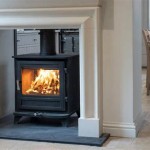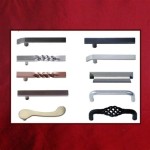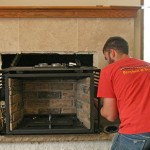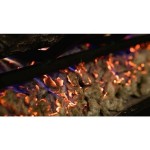Fireplace Hanging Screens: Safety, Style, and Selection
Fireplace hanging screens represent a crucial component of fireplace safety and design. They serve the vital function of containing sparks and embers, preventing them from escaping the firebox and potentially causing damage or injury. Beyond safety, these screens contribute significantly to the aesthetic appeal of a fireplace, offering a range of styles and finishes to complement various interior design schemes. Understanding the different types of hanging screens, their features, and the factors to consider when choosing one is essential for any homeowner with a fireplace.
The primary purpose of a fireplace hanging screen is to provide a physical barrier between the open flame and the surrounding environment. Open fireplaces, while aesthetically pleasing, pose a considerable risk due to the unpredictable nature of burning wood. Sparks can easily pop out of the fire, landing on carpets, furniture, or even clothing. Embers, small pieces of burning wood, can also escape and smolder unnoticed for extended periods, significantly increasing the risk of a fire. A well-chosen and properly installed hanging screen effectively mitigates these risks.
Furthermore, fireplace hanging screens can protect young children and pets from accidental contact with the hot firebox. While supervision is always paramount, a screen provides an added layer of safety, preventing curious hands or paws from getting too close to the flames. This is especially important in homes where children or pets are frequently present.
Key Point 1: Understanding Different Types of Fireplace Hanging Screens
Fireplace hanging screens are available in diverse materials and styles, each offering unique advantages. The most common types include mesh screens, glass screens, and decorative screens. Understanding the characteristics of each type will help in selecting the most suitable screen for specific needs and preferences.
Mesh Screens: Mesh screens are the most prevalent type, characterized by their woven metal construction. They are typically made from steel or iron and are designed to effectively contain sparks and embers while allowing heat to radiate into the room. Mesh screens are often the most affordable option and come in a variety of styles, from simple and functional to more decorative designs featuring intricate patterns or embellishments. The mesh size is a crucial consideration; a finer mesh will offer greater protection against smaller sparks, while a coarser mesh may allow for slightly better airflow. Selecting the appropriate mesh size is therefore a balance between optimal safety and efficient heat distribution.
Glass Screens: Glass screens provide a more contemporary and visually unobtrusive alternative to mesh screens. Typically made from tempered glass, these screens offer a clear view of the fire while still providing a barrier against sparks and embers. Glass screens often feature metal frames for added durability and stability. A significant advantage of glass screens is their ease of cleaning; they can be wiped clean with a glass cleaner, maintaining a pristine appearance. However, glass screens may not be as effective at radiating heat as mesh screens, as they tend to block a portion of the radiant heat. Additionally, they are typically more expensive than mesh screens.
Decorative Screens: Decorative screens prioritize aesthetic appeal and can incorporate various materials and designs. These screens may feature intricate metalwork, ceramic tiles, or even artistic glass panels. While they may offer some degree of protection against sparks, their primary function is to enhance the visual appeal of the fireplace. Decorative screens are often chosen to complement specific interior design themes, adding a touch of elegance or personality to the living space. It is important to carefully assess the protective capabilities of a decorative screen, ensuring that it provides adequate protection against sparks and embers before prioritizing aesthetics.
Key Point 2: Factors to Consider When Choosing a Fireplace Hanging Screen
Selecting the right fireplace hanging screen involves careful consideration of several factors, including size, material, style, and safety features. A well-informed decision will ensure that the screen effectively protects the home while complementing the overall aesthetic of the fireplace.
Size and Fit: Accurate measurements of the firebox opening are essential to ensure a proper fit. The screen should be wide enough to completely cover the opening, preventing sparks and embers from escaping around the edges. It should also be tall enough to offer adequate protection, especially during periods of high flame activity. A screen that is too small will be ineffective at containing sparks, while a screen that is too large may look awkward and detract from the visual appeal of the fireplace. Many retailers offer screens in standard sizes, but custom-made screens are also available for fireplaces with unusual dimensions.
Material and Durability: The material of the screen will impact its durability, heat resistance, and overall aesthetic. Steel and iron are commonly used for mesh screens, offering good heat resistance and durability. Tempered glass is used for glass screens, providing a clear view of the fire but potentially blocking some heat. The frame of the screen should be made from a sturdy material that can withstand the heat of the fire without warping or bending. The quality of the materials used will directly impact the lifespan of the screen.
Style and Design: The style of the screen should complement the overall design of the room and the fireplace itself. A wide range of styles are available, from traditional and ornate to modern and minimalist. Consider the existing décor and choose a screen that enhances the visual appeal of the fireplace without clashing with the surrounding environment. Finishes such as black, bronze, and brushed nickel are common and can be chosen to match other hardware in the room.
Safety Features: Certain safety features can enhance the effectiveness of a fireplace hanging screen. These features include a sturdy frame, a fine mesh, and a secure locking mechanism. A well-constructed frame will prevent the screen from collapsing or warping under heat. A fine mesh will effectively contain even the smallest sparks. A secure locking mechanism will prevent the screen from accidentally opening or being knocked over.
Key Point 3: Installation and Maintenance of Fireplace Hanging Screens
Proper installation and regular maintenance are crucial to ensure the longevity and effectiveness of a fireplace hanging screen. Following the manufacturer's instructions and performing routine maintenance will help keep the screen in optimal condition.
Installation: The installation process typically involves attaching the screen to the fireplace opening using hooks or brackets. The specific installation method will vary depending on the type of screen and the design of the fireplace. Carefully follow the manufacturer's instructions and ensure that the screen is securely attached to prevent it from falling or being dislodged. For heavier screens, it may be necessary to reinforce the attachment points to provide added support.
Cleaning: Regular cleaning is essential to maintain the appearance and functionality of the screen. Mesh screens can be cleaned with a brush and a mild detergent to remove soot and ash. Glass screens can be cleaned with a glass cleaner and a soft cloth. Avoid using abrasive cleaners or scouring pads, as these can damage the surface of the screen. Regular cleaning will prevent the accumulation of soot and ash, which can reduce the screen's effectiveness and detract from its appearance.
Inspection: Regularly inspect the screen for any signs of damage, such as rust, cracks, or loose joints. Repair any damage promptly to prevent further deterioration and maintain the screen's safety and effectiveness. Rust can be removed with a wire brush and a rust-inhibiting paint. Cracks in the frame or glass should be repaired or replaced immediately. Loose joints can be tightened or reinforced with epoxy. Early detection and repair of damage will extend the lifespan of the screen.
Storage: When the fireplace is not in use, consider storing the screen in a safe place to protect it from damage. Store the screen in a dry location to prevent rust and corrosion. Cover the screen with a cloth or plastic sheet to protect it from dust and scratches. Proper storage will help keep the screen in good condition and extend its lifespan.
By paying attention to these key aspects of selection, installation, and maintenance, homeowners can ensure that their fireplace hanging screen provides both safety and aesthetic enhancement to their living space. Choosing the right screen requires a careful assessment of individual needs, preferences, and fireplace characteristics.

Fireplace Mesh Valance Screens

Mesh Hanging Fireplace Screen Woodland Direct

Hanging Fireplace Screen Atticmag

Stoll Hanging Style Mesh Fireplace Screens Mazzeo S Stoves Fireplaces

Rod And Valance Kits

Fireplace Replacement Black Hanging Mesh Curtain Screens China Metal Made In Com

Condar Fireplace Mesh Screens

Stoll Essential Collection Hanging Mesh Kit Fireside Hearth And Leisure

Stoll Hanging Mesh Kits Stylish Fireplaces

Fireplace Mesh Screens By Condar








